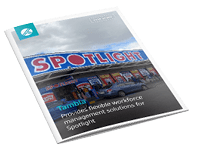Spotlight
Spotlight Retail Group (SRG) encompasses two of Australia’s favourite retail brands, Spotlight and Anaconda.
Spotlight is Australia’s largest fabric, craft/party, and home interiors super-store, while Anaconda is Australia’s largest outdoor adventure and sports superstore.
SRG was founded on a business philosophy that traces its evolution right back to years of operating out of Melbourne’s Queen Victoria Market; a philosophy that places people at the center of every level and facet of the business and still holds true to this day. From those beginnings, SRG has brought new and revolutionary concepts to the retail scene, becoming a major player in the marketplace by owner-operating several brands.
Via its two key brands, SRG own and operates over 170 stores throughout Australasia, including operations in New Zealand, Singapore, and Malaysia, covering over 4.2 million square feet of retail space and employing over 7,000 staff.
The Challenge
With SRG’s retail network continuing to grow, pressure began to mount on its existing staff timesheet and payroll workflow.
Completely paper-based, the system used a folder in each store containing a sheet for each employee. Staff would sign in on their sheet at the start of a shift and off again at the end. Each week, all sheets would be collected and sent to the company’s central payroll office for processing.
“This is the way we had operated for years,” says Gail Byrne, HR T&A Representative, Spotlight. “While it worked when the company was smaller, we had reached the point where we had more than 4000 staff across Australia and New Zealand and things needed to change.”
Each Monday, seven payroll officers would spend around five hours each collating information from the paper timesheets and enter it into the company’s payroll system. If anything was unclear or missing, stores would have to be phoned for explanations.
“We also faced challenges when it came to interpreting award and agreement conditions,” says Byrne. “We relied on managers in each store to interpret the awards and agreements for things such as penalties and overtime. “We would need to spend a large amount of time with managers to ensure that team members were paid correctly.
“It was clear to us that things needed to change. In late 2011, we issued a request to tender and set out to find a new system that could help streamline our timesheet capturing methods.”
The Solution
The search resulted in six organisations being invited to tender. After exhaustive examination and testing, a decision was made to adopt Tambla WFM.
Byrne says Tambla WFM was chosen because it met a range of key criteria. Tambla was an Australian company, which ensured a thorough understanding of the often complex workplace agreements in place within the industry. The company also demonstrated it could provide support in the New Zealand market.
“We also wanted to be sure we had technical support available in the same time zone,” says Byrne. “It was important for us to be sure that, if any technical challenges arose, they could be addressed quickly.”
Once the decision had been made, an implementation project plan was drawn up. The first step was for a six to nine-month pilot in 12 selected stores across Australia. “We chose a mix of city and regional stores as well as both large and small. We wanted to see exactly how it would work for our staff.”
Two Bio mini fingerprint scanners were installed in each pilot store. Rather than needing to sign a piece of paper, staff could simply scan in and out at the beginning and end of their shifts.
Once the pilot had been completed, a state-by-state rollout was undertaken. Within 18 months, all stores in both Australia and New Zealand were live with Tambla solution.
The Benefits
Once staff had been trained in how to use the new system and became comfortable with its use, business benefits were seen immediately.
“Because store managers were no longer having to interpret awards and conditions, the accuracy of our wage payments increased immediately,” says Byrne. “We were also better able to capture details of staff annual and sick leave entitlements.”
Tambla WFM also brought big benefits for the central payroll team. Rather than occupying seven staff for five hours every week, loading the information into the payroll system is completed by two people in just one hour, a saving of one full-time equivalent staff.
“This is particularly significant when you consider that we have now grown from 4000 to more than 7000 staff across the company. There is simply no way we could have coped with this growth if we still had the manual, paper-based system in place.”
Future plans include making use of Tambla WFM’s volume rostering features, which will allow stores to better match staff numbers to times of peak customer demand. The company is also scoping out the potential to make use of Tambla WFM in its stores in Singapore and Malaysia with its HTLM5 release.
“Tambla WFM has revolutionised the way we handle our payroll each week,” says Byrne.

